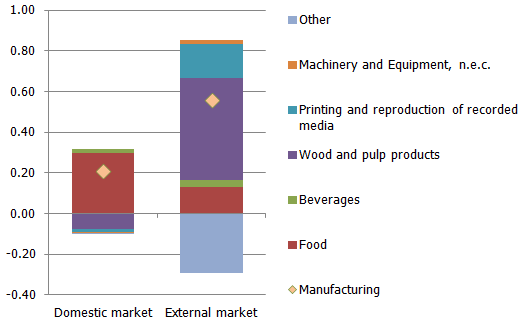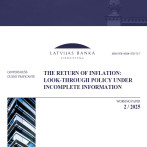Producer prices in October influenced by production cost increases in manufacturing
In October 2012, the annual rate of increase in producer prices reached 2.9%, which is less than the average in the first 10 months, with a slight upward trend. Month-on-month the increase was at 0.2%, with producer prices unchanged for goods sold domestically.
The branch by branch contribution of manufacturing to the month-on-month increase in producer prices in October, pp

Source: CSB
The rise in producer prices in October was primarily determined by production cost increases in several branches of manufacturing, and under the influence of the range of production a more rapid rise was observed for the part of production of these branches that was meant for export (See Fig. 1). This difference may be explained both by the different ranges of production aimed at the different markets and using different raw materials and by differences in price policies for different markets influenced by purchasing power. Moreover, this trend supports what we have said before, i.e. that in the domestic market there are currently no signs that would point to a possible increase in inflation pressure in the near future.
Producer prices rose also in the production of wearing apparel, beverages and foodstuffs (in this branch the increase was symmetrical for both market directions, at 1.3%). The appreciation of the costs of foodstuffs production could probably be related to the costs of raw materials, because the rise in food prices that has already abated in the global market is gradually entering Latvian producer prices (to be followed by consumer prices).
Any relation that the dynamics of labour costs may have to the rise in producer prices is very slight.. First, the rise in productivity in manufacturing is rapid, therefore salary rises are well founded and do not raise the cost of a production unit. Second, the lack of labour as an important impediment to production is observed only in some sub-branches of manufacturing
According to the European Commission business tendency data, shortages of labour in the fourth quarter are mentioned as the main obstacle to business by 8.7% of industrial enterprises and they are mostly observed in the production of durable consumer goods, particularly wearing apparel, furniture and transport vehicles (24.3%, 16.5% and 14.5% respectively). In the food industry and wood and pulp industry labour shortages are mentioned much more seldom. Of the branches where they have been mentioned in at least 10% of cases, producer prices have risen only in the production of wearing apparel, whereas in other branches (e.g., the production of furniture, transport vehicles, electrical equipment, chemicals and metal products) they dropped or remained unchanged in October. At the same time, producer prices are rising in branches that do not complain (or hardly complain) about labour shortages (e.g., beverage production, printing, pulp production and non-metal mineral products manufacturing).
As expected, producer prices in energy production even dropped somewhat: albeit prices of resources remain high globally and the production of energy in Latvia depends on imports, resource prices did not exhibit an upward trend quite as pronounced as before and the largest energy producers did not rush to apply for new tariff plans or raise prices within the existing ones, e.g. for gas or thermal energy. Those energy producers who had the need or opportunity to change tariffs (including bringing them down as a result of, e.g., updating of their production lines) did not do it across the line as soon as the heating season began. Therefore, as the Public Services Regulatory Commission gradually approves the new tariffs in several Latvian towns and regions, they will impact producer prices moderately and gradually and, in a number of cases, their downward or upward impact on the overall level of producer prices could outweigh each other.
Textual error
«… …»






